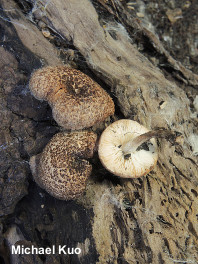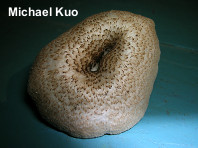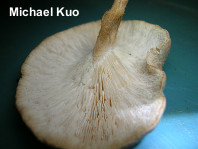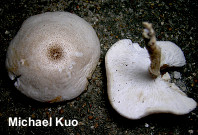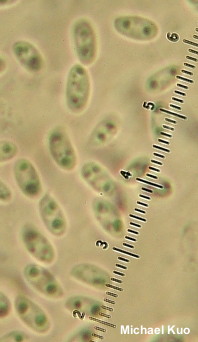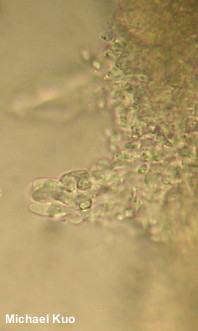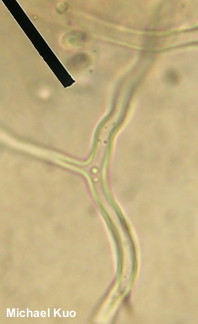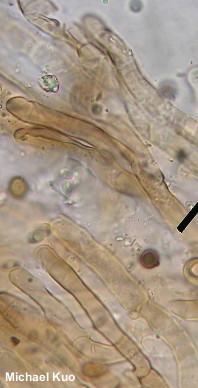| Major Groups > Gilled Mushrooms > Pale-Spored > Lentinus > Lentinus tigrinus |

|
Lentinus tigrinus [ Basidiomycota > Polyporales > Polyporaceae > Lentinus ... ] by Michael Kuo Bulliard first described Lentinus tigrinus from France, in 1782, as "L'agaric tigré," the tiger agaric. Presumably the brown scales on the whitish cap reminded Bulliard of a tiger—perhaps what we might call a leopard these days. The mushroom, he said, is found "in summer and fall in woods on old, rotten trees and more commonly on elms." The elm Bulliard had in mind was probably Ulmus laevis, the European white elm, which is a riverbank species with distribution from Spain to Russia. Why is Michael babbling on about European elms and 18th-century mushroom descriptions? Because, even in North America, Lentinus tigrinus is found on the wood of riverbank trees (willows, cottonwoods, silver maples, and so on)—and its preference for frequently soaked wood in floodplains can be inferred from Bulliard's original description, even though he did not state it directly, since he specified elms as the most common habitat. Lentinus tigrinus is fairly small, and can be identified by its riverine habitat, the navel-like depression in the center of the cap, and the small brown scales. Microscopic features include ellipsoid, inamyloid spores—and some features that are decidedly polypore-ish, like the presence of hyphal pegs and thick-walled binding hyphae. In fact, despite having gills, Lentinus tigrinus is a polypore; DNA studies have placed it unambiguously in the family Polyporaceae. For a discussion of how a mushroom can be a "polypore" but have gills, see "What, If Anything, Is a Gilled Mushroom?" on the page for another gilled polypore, Lenzites betulinus. And now we come to the weird part of the Lentinus tigrinus story. In North America, a form of the species is commonly encountered in which the gills are malformed and appear covered with a partial veil or Hypomyces of some kind. Kauffman (1918) called it a "monstrous form" and a "monstrosity"; Smith (1979) called it an "abortive stage." Although Morgan (1895) thought this aberrant mushroom was a separate species that should even be given a separate genus (as "Lentodium squamulosum"), later mating studies discovered that the normal and gasteroid forms could mate easily, demonstrating "complete intercompatibility" (Rosinski & Robison, 1968) and producing offspring in the normal form. Recent study of Lentinus tigrinus by Grand (2004) shows clear separation between North American and non-North American (Eurasian and Australian) populations in their DNA—but the populations have retained the ability to mate successfully; "widely scattered geographical populations of the L. tigrinus complex are genetically divergent, but are still capable of exchanging genetic material when they contact each other" in petri dishes. Description: Ecology: Saprobic; growing alone, scattered, or, more frequently, gregariously to loosely clustered on the wood of hardwoods—usually in floodplains on wood that is subject to regular wetting by streams, rivers, and so on; spring through fall, or over winter in warmer climates; widely distributed from the Great Plains eastward, and in the Southwest; most common in the southeastern states. The illustrated and described collections are from Illinois and Missouri. Cap: 1–3 cm wide; broadly convex, with a prominent, navel-like central depression; dry; fibrillose-scaly with small, dark brown scales over a tan to brown ground; the margin incurved and not lined. Gills: In the "normal" form (see discussion above) running down the stem; crowded; edges becoming slightly serrated; short-gills frequent; white to creamy. In another form malformed or nearly absent; appearing as if covered with a white partial veil or Hypomyces. Stem: 2–4 cm long; 2–5 mm wide; equal, or slightly tapered toward the base; dry; scaly with fine brown scales like those on the cap when fresh and young, but often losing the scales quickly and appearing fibrillose or even bald; whitish toward the apex; brownish to brown below; with a whitish to brownish, ephemeral ring zone when fresh and young. Flesh: Whitish; unchanging when sliced. Odor and Taste: Not distinctive. Spore Print: White. Microscopic Features: Spores 5–7 x 2–3.5 µm; ellipsoid; smooth; hyaline in KOH; inamyloid. Basidia 4-spored. Cheilocystidia basidiole-like and generally hard to distinguish, but thick-walled binding hyphae protrude from the lamellar edge. Pleurocystidia not found. Hyphal pegs present; extending 40–60 µm from the hymenium; 12–20 µm wide in the aggregate; individual hyphae 4–6 µm wide, smooth, hyaline in KOH, thin-walled, clamped. Pileipellis a partially gelatinized cutis with scattered upright, fascicled aggregations (the scales); elements 2.5–7 µm wide, hyaline to brown in KOH, smooth or finely encrusted, clamped. REFERENCES: (Bulliard, 1782) Fries, 1825. (Fries, 1821; Saccardo, 1887; Kauffman, 1918; Rosinski & Robison, 1968; Smith, Smith & Weber, 1979; Pegler, 1983; Breitenbach & Kränzlin, 1991; Phillips, 1991/2005; McNeil, 2006; Miller & Miller, 2006; Justo et al., 2017.) Herb. Kuo 06051601. This site contains no information about the edibility or toxicity of mushrooms. |
© MushroomExpert.Com |
|
Cite this page as: Kuo, M. (2017, December). Lentinus tigrinus. Retrieved from the MushroomExpert.Com Web site: http://www.mushroomexpert.com/lentinus_tigrinus.html |
